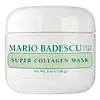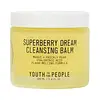What's inside
What's inside
 Key Ingredients
Key Ingredients

 Benefits
Benefits

 Concerns
Concerns

 Ingredients Side-by-side
Ingredients Side-by-side

Water
Skin ConditioningKaolin
AbrasiveTalc
AbrasivePropylene Glycol
HumectantAvena Sativa Kernel Flour
AbrasiveSorbitol
HumectantZinc Oxide
Cosmetic ColorantTriticum Vulgare Starch
AbrasiveCollagen
MoisturisingCellulose Gum
Emulsion StabilisingCarrageenan
Sodium Chloride
MaskingParfum
MaskingMethylparaben
PreservativePhenoxyethanol
PreservativeCI 42090
Cosmetic ColorantCI 19140
Cosmetic ColorantHelianthus Annuus Seed Oil
EmollientCaprylic/Capric Triglyceride
MaskingOryza Sativa Bran Wax
Skin ConditioningPolyglyceryl-2 Sesquicaprylate
EmulsifyingPolyglyceryl-6 Distearate
EmulsifyingWater
Skin ConditioningPolyhydroxystearic Acid
EmulsifyingSimmondsia Chinensis Seed Oil
EmollientMoringa Oleifera Seed Oil
EmollientSorbitan Olivate
EmulsifyingHydrolyzed Sodium Hyaluronate
Skin ConditioningSodium Hyaluronate
HumectantOpuntia Ficus-Indica Stem Extract
Skin ConditioningAristotelia Chilensis Fruit Extract
Skin ConditioningEuterpe Oleracea Fruit Extract
Lycium Barbarum Fruit Extract
AstringentMoringa Oleifera Leaf Extract
Skin ConditioningOpuntia Tuna Flower/Stem Extract
Skin ConditioningMelia Azadirachta Flower Extract
Skin ConditioningMelia Azadirachta Leaf Extract
Skin ConditioningOcimum Sanctum Leaf Extract
Skin ConditioningCurcuma Longa Root Extract
MaskingOcimum Basilicum Flower/Leaf Extract
TonicCorallina Officinalis Extract
Skin ConditioningRicinus Communis Seed Oil
MaskingHydrogenated Castor Oil
EmollientTocopherol
AntioxidantSodium Laurylglucosides Hydroxypropylsulfonate
CleansingCaprylyl Glycol
EmollientSodium Chloride
MaskingEthylhexylglycerin
Skin ConditioningPhenoxyethanol
PreservativeHexylene Glycol
EmulsifyingParfum
MaskingHelianthus Annuus Seed Oil, Caprylic/Capric Triglyceride, Oryza Sativa Bran Wax, Polyglyceryl-2 Sesquicaprylate, Polyglyceryl-6 Distearate, Water, Polyhydroxystearic Acid, Simmondsia Chinensis Seed Oil, Moringa Oleifera Seed Oil, Sorbitan Olivate, Hydrolyzed Sodium Hyaluronate, Sodium Hyaluronate, Opuntia Ficus-Indica Stem Extract, Aristotelia Chilensis Fruit Extract, Euterpe Oleracea Fruit Extract, Lycium Barbarum Fruit Extract, Moringa Oleifera Leaf Extract, Opuntia Tuna Flower/Stem Extract, Melia Azadirachta Flower Extract, Melia Azadirachta Leaf Extract, Ocimum Sanctum Leaf Extract, Curcuma Longa Root Extract, Ocimum Basilicum Flower/Leaf Extract, Corallina Officinalis Extract, Ricinus Communis Seed Oil, Hydrogenated Castor Oil, Tocopherol, Sodium Laurylglucosides Hydroxypropylsulfonate, Caprylyl Glycol, Sodium Chloride, Ethylhexylglycerin, Phenoxyethanol, Hexylene Glycol, Parfum
 Reviews
Reviews

Ingredients Explained
These ingredients are found in both products.
Ingredients higher up in an ingredient list are typically present in a larger amount.
Parfum is a catch-all term for an ingredient or more that is used to give a scent to products.
Also called "fragrance", this ingredient can be a blend of hundreds of chemicals or plant oils. This means every product with "fragrance" or "parfum" in the ingredients list is a different mixture.
For instance, Habanolide is a proprietary trade name for a specific aroma chemical. When used as a fragrance ingredient in cosmetics, most aroma chemicals fall under the broad labeling category of “FRAGRANCE” or “PARFUM” according to EU and US regulations.
The term 'parfum' or 'fragrance' is not regulated in many countries. In many cases, it is up to the brand to define this term.
For instance, many brands choose to label themselves as "fragrance-free" because they are not using synthetic fragrances. However, their products may still contain ingredients such as essential oils that are considered a fragrance by INCI standards.
One example is Calendula flower extract. Calendula is an essential oil that still imparts a scent or 'fragrance'.
Depending on the blend, the ingredients in the mixture can cause allergies and sensitivities on the skin. Some ingredients that are known EU allergens include linalool and citronellol.
Parfum can also be used to mask or cover an unpleasant scent.
The bottom line is: not all fragrances/parfum/ingredients are created equally. If you are worried about fragrances, we recommend taking a closer look at an ingredient. And of course, we always recommend speaking with a professional.
Learn more about ParfumPhenoxyethanol is a preservative that has germicide, antimicrobial, and aromatic properties. Studies show that phenoxyethanol can prevent microbial growth. By itself, it has a scent that is similar to that of a rose.
It's often used in formulations along with Caprylyl Glycol to preserve the shelf life of products.
Chances are, you eat sodium chloride every day. Sodium Chloride is also known as table salt.
This ingredient has many purposes in skincare: thickener, emulsifier, and exfoliator.
You'll most likely find this ingredient in cleansers where it is used to create a gel-like texture. As an emulsifier, it also prevents ingredients from separating.
There is much debate on whether this ingredient is comedogenic. The short answer - comedogenic ratings don't tell the whole story. Learn more about comegodenic ratings here.
The concensus about this ingredient causing acne seems to be divided. Research is needed to understand if this ingredient does cause acne.
Scrubs may use salt as the primary exfoliating ingredient.
Learn more about Sodium ChlorideWater. It's the most common cosmetic ingredient of all. You'll usually see it at the top of ingredient lists, meaning that it makes up the largest part of the product.
So why is it so popular? Water most often acts as a solvent - this means that it helps dissolve other ingredients into the formulation.
You'll also recognize water as that liquid we all need to stay alive. If you see this, drink a glass of water. Stay hydrated!
Learn more about Water